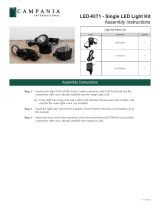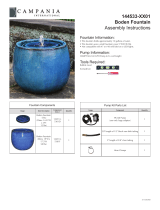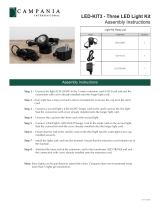Page is loading ...

FT-277 Rittenhouse Fountain
Assembly Instructions
rev 4/6/2020
Fountain Information:
• Two people are recommended for the installation of this fountain!
• This fountain holds approximately 20 gallons of water.
• This fountain uses a medium fountain cover: FTNCOV-MED
• Compatible with #10 Refill Device and LED kits
• A special stopper is required to use the refill kit for this fountain
Pump Information:
OEMPF320 - 320 GPH Pump (16 ft. cord length)
Tools Required:
Bubble Level
Screwdriver
Pump Kit Parts List
Image Component Quantity
PK300 Pump
(use adapter indicated) 1
#10 Stopper 1
20" length of 1/2" black non-kink tubing 1
1.5" length of 5/8" clear tubing 1
1.5" length of 1/2" CPVC pipe 1
Copper Spillers
(FT-277SPL) 4
2.8 oz tube of silicone 1
Wedges 4
Hose Clamps 1
Fountain Components
Image Item Description Component
Item # Quantity
Rittenhouse
Fountain - Disc FT-277A 1
Rittenhouse
Fountain -
Water Feature
FT-277B 1
Rittenhouse
Fountain -
Column
FT-277C 1
Rittenhouse
Fountain -
Pump Cover
FT-277D 1
Rittenhouse
Fountain -
Pump Cover
Door
FT-277E 1
Rittenhouse
Fountain - Basin FT-277F 1
Proudly
MADE IN USA

FT-277 Rittenhouse Fountain
Assembly Instructions
Two people are recommended for the installation of this fountain!
Assemble your fountain on a level surface capable of holding a minimum of 435 lbs with an
approximate 4.5 sq. ft. footprint (actual dimensions 29.25" x 29.25").
Step 1 - Place the basin (FT-277F) into position where the fountain will be installed, ensuring that
it is level.
Step 2 - Assemble the pump kit:
2a - Using a hose clamp, attach the 1/2" non-kink tubing to the pump outlet.
2b - Place the stopper around the pump cord approximately 8" from the pump.
Step 3 - Feed the pump cord through the hole in the basin (FT-277F) and the channel.
Step 4 - FIRMLY press the stopper into the hole evenly.
4a - Note: Using the handle of a screwdriver or hammer works best to press the stopper in
place.
FT-277F (178 lbs)
30"L x 30"W x 9.75"H
Fountain Set-Up:
Assembly & Installation - A fountain can be difficult to install without knowing and understanding the steps involved. To ensure your fountain is
installed properly, please read our instructions and tips before you begin.
Step 1 - Seek Professional Help: Check if professional installation is recommended for your fountain.
Step 2 - Check Foundation: Place your fountain on a level surface. It is recommended to place your fountain on concrete or a hard packed
gravel pad. If the base is level but some components seem off, rotate components or use wedges to level them.
Step 3 - Create a Drip Loop: To prevent water from dripping down the cord and damaging the electrical socket, create a drip loop by allowing
the pump power cord to fall below the wall outlet.
Step 4 - Use a GFCI Outlet: Use only a GFCI outlet when running a fountain.
Step 5 - Place the pump house (FT-277D) over the pump and in the center of the basin (FT-277F).
Step 6 - Center the pedestal (FT-277C) over the pump house (FT-277D).
Step 7 - Feed the tubing connected to the pump through the hole in the center of the pedestal
(FT-277C).
FT-277D (22 lbs)
8.5"L x 8.5"W x 7.5"H
FT-277C (31 lbs)
7"L x 7"W x 9"H

FT-277 Rittenhouse Fountain
Assembly Instructions
Step 8 - Center the bowl (FT-277B) over the pedestal (FT-277C).
Step 9 - Insert the CPVC end of the preassembled tubing to the CPVC coupling protruding from
the bottom of the bowl (FT-277B).
Step 10 - Use the silicone provided to attach the copper spillers
10a - Lip of the spillers should be on the inside of the bowl.
10b - Clean away any excess silicone.
Step 11 - Place the water control disc (FT-277A) into the bowl (FT-277B).
Step 12 - Fit the pump house door (FT-277E) into the pump house (FT-277D).
Step 13 - Let the fountain sit 24 hours before filling with water.
FT-277B (28 lbs)
15.5"W x 28"H
FT-277A (2 lbs)
6.75"W x 1"H
FT-277E (3 lbs)
4"L x 1"W x 5"H

Troubleshooting:
Pump Not Working - When operating the pump for the first time, it can take a few minutes before water begins to flow properly. If it is still not working after
a few minutes, please follow our troubleshooting tips below. Before troubleshooting, UNPLUG YOUR PUMP.
Step 1 - Submerge Pump: Ensure your pump is fully submerged in water at all times to avoid pump damage.
Step 2 - Manual Check: If the pump cover is removable, try removing the cover to access the impeller area. Turn the rotor to ensure it is not broken or
jammed.
Pump Noise - Some sound from the pump may be normal, but you can follow these tips to reduce sound or resolve abnormal noises.
Step 1 - Submerge Pump: Ensure your pump is fully submerged at all times and clean of debris, dirt and algae buildup.
Step 2 - Check Location: You may hear the vibration of the pump touching the side walls of the fountain. Make sure the pump is only touching the bottom.
Step 3 - Check Flow Rate: Too low of a flow rate might cause spews or burps.
Water Flow Rate - Some fountains come with a dial or valve to adjust the flow rate, but if you do not have this option or if you are still unsatisfied with your
flow rate after changing the settings, check out our tips below.
Step 1 - Adjust the Water Level: Insufficient water levels can affect water intake by the pump. Check the fountain instructions to ensure the appropriate
water capacity for your fountain.
Step 2 - Check for Kinks: Check to make sure the tubing is not kinked. Kinks in the tubing can slow or halt the flow of water.
Step 3 - Clamp the Hose: To slow the water flow, try clamping the hose with a hose clamp or zip-tie.
Splashing - Having trouble with splashing? Some splashing is inevitable, especially when you first turn on your fountain, but if you are experiencing
excessive splashing, try our troubleshooting tips below.
Step 1 - Adjust the Water Level: Ensure the pump is fully submerged, but avoid overfilling your fountain.
Step 2 - Flow Rate: If your pump includes a dial or valve to adjust the flow rate, try changing the settings to see if it affects splashing. If your pump is
not adjustable, check our Flow Rate section to learn about other ways to change the flow rate.
Step 3 - Adjust Position: Try arranging stones or placing a splash guard, at the fountain base. You can also place a screen in the basin.
Leaking - If your fountain is leaking, check these quick tips on how to fix it.
Step 1 - Adjust the Water Level: Your fountain may leak if it is too full.
Step 2 - Check Tubing: Check that the tubing is attached completely and correctly.
Step 3 - Check Stopper: Ensure stopper is completely seated in the fountain. You can also use 100% pure clear silicone to ensure a proper seal is achieved
Step 4 - Cracking: Your fountain may be cracked from improper winter care; see Winter Care in Maintenance Tips.
Maintenance:
Pump Care - The fountain relies heavily on the quality of the pump. A well-maintained pump can last several years.
Step 1 - Fully submerge: Ensure the pump is fully submerged at all times to avoid damage.
Step 2 - Ensure water level is sufficient: Check water levels regularly as water may evaporate over time, and periodically change water to avoid algae
buildup.
Step 3 - Clean pump: Use soap and water, or white vinegar and water, with a small, soft brush to clean the pump of debris, dirt, and algae buildup.
This should be done every 2-3 months.
Surface Care - Paints and finishes may fade over time due to weathering. By following these tips, you will be able to maintain your fountain’s surface.
Step 1 - Control Algae and White Scale: Due to water evaporation, you may see white residue on your fountain surface from the mineral content in
your water supply. Algaecides and cleansers can help prevent buildup that occurs from minerals and hard water.
Step 2 - Protect and Refinish: Depending on the material of your fountain, protectants and sprays may prolong the appearance of the surface. Paint and
refinishing kits can be used for touch-up.
Winter Care - Many materials used to produce fountains can expand and contract in different temperatures/humidity levels. If the temperature falls below
32°F or humidity levels change drastically, follow the steps below to protect your fountain.
Step 1 - Bring inside: If possible, bring your outdoor fountain inside for the winter.
Step 2 - Store in dry location: If unable to bring inside, store your fountain in a dry and covered location.
Step 3 - Bring components inside: Move all internal components (stoppers, tubing, lights, pump, etc) inside. A pump can stay in a fountain for the
winter, but if you choose to leave it in, it must be completely dry and insulated with plastic bags and towel to ensure it stays dry. However it is
recommended to bring it inside.
Step 4 - Completely drain: It is important to prevent water from accumulating anywhere, as freezing and thawing of water can cause pump damage
and cause cracks to form in your fountain. Remove the drain plugs.
Step 5 - Elevate Fountain: Fountains may freeze to the ground and cause cracking in the base if left outside in the winter. If unable to store inside or in
a dry covered location, try to raise your fountain above ground.
Step 6 - Cover Fountain: Make sure to use a breathable material when covering. DO NOT COVER IN PLASTIC! Make sure the fountain is taut so that
no snow or water can pool in the cover. Tie the opening at the bottom of the cover around the fountain.
/









